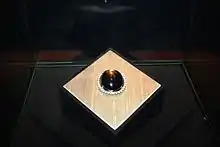Black Star of Queensland
The Black Star of Queensland, named after its nature and place of origin, is a 733-carat (146.6 g) black sapphire, and was the world's largest gem quality star sapphire until The Star of Adam was discovered.
| Black Star of Queensland, Star Sapphire | |
|---|---|
 The 733-carat Black Star of Queensland | |
| General | |
| Category | Oxide mineral |
| Identification | |
| Color | Black |
The Black Star sapphire is an oval-shaped gemstone cut as a cabochon like all other star sapphires. The center of the star is much bigger and brighter than normal star sapphires. The bright six-ray star is set in a completely black background. The beauty of the stone is further enhanced by its white gold setting. The large black stone is surrounded by a row of 35 pear-shaped smaller white diamonds.
As with all star sapphires, the star moves with changing angles of illumination and observation and belongs to the group of minerals known as corundum, a crystalline form of aluminum oxide (Al2O3).
The star effect in star sapphires is caused by microscopic inclusions, mainly rutile, aligned in a threefold pattern inside the stone that reflects the light entering the stone through its dome shaped face into a six-ray star pattern.
In 1947, Harry Spencer[1] agreed to sell the stone to Armenian-born jeweler Harry Kazanjian for $18,000, with which Spencer built a new house for his family. Kazanjian spent two months studying the stone before making the decision to cut it, sacrificing over 400 carats to reveal the six pointed star.
The gemstone was loaned to the Smithsonian Institution's National Museum of Natural History in Washington, D.C., in 1969, and in 1971 it received some brief television fame when the stone featured around the neck of Cher.[2] Since this time, in spite of a small number of charity events, the stone has rarely been seen in public.
Eager to fulfill a childhood dream, with an overwhelming desire to own the stone, jeweler and artist Jack Armstrong,[3][4] along with his wealthy girlfriend Gabrielle Grohe,[5] convinced the Kazanjian family to sell the stone to fund a scholarship at the Gemological Institute of America.
A lengthy, controversial and bitter international ownership battle between Armstrong and Grohe ensued, marked by the New York Post which ran a story with the headline "Heavyweight Gem $cuffle[6]”. The legal dispute ended quietly outside of court in a confidential agreement. According to court documents, Armstrong agreed to pay $500,000 within three months to buy out Grohe.
References
- "The Black Star of Queensland Famous Black Sapphire Gemstone". jewelry-blog.internetstones.com. Retrieved 26 July 2017.
- hsc1960 (2 September 2015). "World's Largest Gem-Quality Star Sapphire Served as a Dusty Doorstop for Nine Years". The Jeweler Blog. Retrieved 26 July 2017.
- Kim, Victoria. "PressReader.com - Connecting People Through News". www.pressreader.com. Retrieved 26 July 2017.
- nason, pat. "Feature: Legendary sapphire for sale". upi. Retrieved 26 July 2017.
- Kim, Victoria (5 January 2010). "For some, a sapphire has not been their best friend". Los Angeles Times. ISSN 0458-3035. Retrieved 26 July 2017.
- Li, David K. (16 July 2008). "Heavyweight Gem $cuffle". New York Post. Retrieved 26 July 2017.